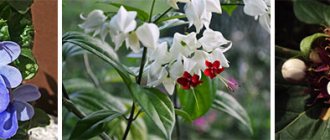A shrub such as lilac is a member of the olive family. According to information taken from various sources, this genus includes from 22 to 36 species. In nature, such species can be found in the mountainous regions of Eurasia. The genus lilac has a type species - the common lilac (Syringa vulgaris). Under natural conditions, such a shrub can be found along the lower reaches of the Danube, on the Balkan Peninsula and in the Southern Carpathians. Lilac is cultivated as an ornamental plant, and it is also used to strengthen and protect slopes that are subject to erosion. In the second half of the 16th century, the Roman ambassador brought lilacs to European countries from Constantinople, and since that time this plant has appeared in the gardens of Europe. The Turks called this shrub “lilac”, and the inhabitants of Germany, Flanders and Austria gave it the name “lilac” or “Turkish viburnum”.
At first, lilac was not in great demand among European gardeners, because it did not bloom long, and the loose inflorescences with small flowers were not highly decorative. But everything changed after the Frenchman V. Lemoine received several dozen varieties of this plant, which were distinguished by lush and long-lasting flowering, as well as beautiful dense inflorescences with the correct shape. He also managed to develop several varieties with double flowers of various colors. Emile Lemoine continued his father's activities, as did his son Henri. Thanks to the Lemoines, 214 varieties of lilac were born. Among the French lilac breeders who paid attention were: Auguste Gouchot, Charles Baltet and Francois Marel. At the same time, in Germany, Wilhelm Pfitzer and Ludwig Speth worked on developing new varieties of lilac. In Holland, at the beginning of the 20th century, new varieties of this shrub were born, and Klaas Kessen, Dirk Evelens Maarse, Jan van Tol and Hugo Coster worked on this, and the Polish breeder Karpov-Lipski also worked in this direction.
At the beginning of the 20th century, lilac became quite popular in North America, and new varieties were born thanks to breeders such as John Dunbar, Gulda Klager, Theodor Havemeyer and other fairly well-known specialists from Canada and the USA. Also, new varieties of lilac were bred in Belarus, Russia, Ukraine and Kazakhstan. Today, there are more than 2,300 varieties of this plant, which differ in color, size and shape of flowers, flowering time, habit and size of bushes. 2/3 of all varieties were bred using common lilac.
Types and varieties of bush lilac
Although lilac is a fairly tall plant, it is classified as a shrub. Lilac genus Shrubs, Olive family. Currently, more than 30 species are known, most of them wild plants. They can be found in Southeast Europe and Asia (mainly China). Just like domestic varieties, wild representatives of this genus have beautiful flowers.
Lilac blossom
Flowers can be of different colors: white, lilac, purple, pink. Collected in a panicle. The leaves are usually entire, oppositely arranged, and fall off in the fall. The fruit is a capsule.
In gardens, different types of lilac can be found in all corners of Eurasia. The most widespread is the common lilac.
Common lilac
Large shrub, up to 6 meters high. The descriptions of all varieties are similar. The leaves are dense, smooth, dark green, up to 12 cm long, located on 3 cm petioles. Flowers of different shades of purple, collected in pyramidal inflorescences, up to 20 cm long, bloom at the age of 4 years. South-Eastern Europe is considered its homeland.
For active flowering, fertile loamy soil is required. It also grows well in poorer soils. Tolerates minor drought, frost resistance is average. Can grow in urban environments, allowing a little shade. The root system is powerful, which must be taken into account when planting.
Lilac in the city
It has a large number of varieties, with different flowering periods and different shades of flowers. Breeders have even developed varieties with yellow and pure pink flowers. The following varieties are popular:
- Lilac variety Hydrangea;
- Dzhambul;
- India;
- Bohdan Khmelnytsky;
- And other varieties.
Persian lilac
As a result of selection, crossing the small cut lilac with the Afghan lilac, the Persian lilac bush was obtained. Its height does not exceed 2 meters, the branches are widely spread out. Young branches have slight pubescence. Mature branches are brown and thin.
The flowers have a strong aroma and are white or white-purple in color. Inflorescences up to 10 cm long and up to 7.5 cm wide develop from the upper lateral buds.
Persian lilac
Persian lilac blooms in May. Fruiting occurs in July-August. Not found in the wild.
Chinese hybrid lilac
In 1777, another type of lilac was obtained in France - the Chinese hybrid. It was bred by crossing common lilac with Persian lilac. This is a powerful shrub with spreading branches, its height reaches 5 m. It has pointed ovoid leaves and large flowers, the diameter of which reaches 1.8 cm. They are collected in panicles, the length of which is up to 10 cm.
After blooming, the flowers have a reddish-purple hue and a delicate, pleasant aroma. Currently, varieties have been bred with white, pink and dark pink double flowers.
Shaggy lilac
It has a second name - hairy. Shrub up to 4 m high. Dense foliage, erect branches. Branches older than 2 years are bare and brownish-yellow in color. Grows in China.
It has fragrant flowers of a delicate purple color, collected in inflorescences, the length of which reaches 15-30 cm. It blooms in June-July. Frost resistance is good. Used for landscaping, both in group plantings and as a hedge.
Lilac Zvyagintseva
It received its name in honor of the governor of Riga - Zvyagintsev. It was discovered recently by the expedition of G.N. Potanin. It grows naturally in the mountain valleys of China.
Variety Zvyagintseva
The height of the bush is up to 5 meters, the crown is dense, the branches are erect. Leaf length is from 4 to 11 cm. There are sparse hairs on top of the leaves. The buds are pink. The flowers are very fragrant. When flowering, the bush looks impressive; the flowering period is about 2 weeks.
Amur lilac
Under natural conditions, it can be found in the Far East and China. Under favorable conditions it grows up to 20 m. In gardens the maximum height is about 10 m.
The biggest disadvantage is that Amur lilac blooms at 9-10 years of age. Flowering is quite long - 20 days. Grows well in urban conditions and is frost-resistant.
Hungarian lilac
In the wild it is found in the Carpathians, Hungary and Yugoslavia. The shrub is relatively low, on average 3-4 m, maximum height is 7 m. There are many branches. The flowers are long, tubular, often purple, and not very fragrant.
The plant is unpretentious and grows quickly even in an urban environment. Tolerates dust and natural anomalies well. Flowering lasts 3-4 weeks.
Family history
The genus Lilac (Syringa) belongs to the olive family and has about 30 species native to Southern Europe, Northeast Asia and Iran. These are deciduous, with rare exceptions, evergreen shrubs with a densely leafy crown. The flowers are bisexual, fragrant, white, lilac, violet, purple in color. Collected in multi-flowered apical or axillary paniculate inflorescences, appearing simultaneously with the blossoming of the leaves.
The fruit is an oblong or oval leathery capsule with two seeds behind each valve.
This is interesting
Lilac is perhaps one of the most popular and beloved crops. The history of its breeding began in 1583. It was then that, calling lilac Turkish viburnum, the Austrian envoy brought the seeds of this unusual plant from Constantinople to Vienna. Since then, it has been leading the list of the most highly decorative and beautifully flowering shrubs.
The homeland of most types of lilac is China, but this beauty has long been cultivated in other countries, where it is treated with great respect, and breeders have created a huge number of magnificent varieties.
In Russia, this plant is also particularly popular and loved. Since ancient times, fragrant lilac bushes have decorated royal and monastery gardens, private estates and parks. Currently, different types of lilac are widely used in urban landscaping and in garden plots.
Types and varieties of tree lilac
Is sea buckthorn a tree or a shrub? Growing sea buckthorn at home
The tree lilac looks a lot like a tree, but is actually a shrub.
Meyer
Compact dwarf lilac bushes of this variety do not grow more than 1.5 m. Over the course of a year, the plant grows only 10 cm. The shoots are brown, the leaves are small, up to 47 cm. The inflorescence length is on average 10 cm. Various colors: white, purple, red . It blooms in the last ten days of May - the first ten days of June. It withstands both harsh winters and dry summers.
Ludwig Speth
A spreading shrub with bright purple flowers collected in a large panicle. Grows up to 3.5 cm. Lives for more than 100 years. Grows quickly. Homeland - Germany.
Miss Canada
An unpretentious plant, reaches a height of 2.5 m. It blooms profusely, the flowers are small, burgundy-red. Prefers sunny areas with loose soil.
Michelle Buechner
Light-loving bush up to 4 m high. Prefers fertile soils with good lighting. It grows well in urban conditions; this variety is used for landscaping. The flowers are double, lilac in color. It blooms at the end of May and blooms for quite a long time.
Madame Lemoine
The variety acquired its name in honor of the wife of the French breeder Victor Lemoine, who bred it. The panicles are large, up to 20 cm in length and up to 8 cm in width. In buds, the petals are initially green, but when they bloom, they change color to white. Blooms profusely every year.
Beauty of Moscow
This beautiful variety is distinguished by double flowers, similar to rose flowers. The color is pinkish-white. The diameter of the flower reaches 2.5 cm, the length of the panicle is 25 cm.
Moscow beauty
Blooms for a long time. A very beautiful and unusual variety.
Sensation
The variety got its name for its unusual flowers, bright purple with a white border. The flowers are large, with a faint aroma. The leaves are dark green. Mainly propagated by cuttings.
Accubifolia
It differs from other varieties in its unusual variegated foliage color. The flowers are semi-double, quite large, with a strong aroma. The bush is tall, under favorable conditions it grows up to 4 m.
Types and varieties of indoor lilacs
Juniper - shrub or tree, how to propagate and plant it
It is almost impossible to grow lilacs in a house or apartment. But there is a plant called plectranthus hybridus. Its second name is indoor lilac. Those who see it for the first time immediately wonder: are lilacs flowers or a shrub?
Its feature is long flowering. The bush blooms in February and blooms until the end of autumn. Grows well in a pot on the windowsill. The flowers are lilac and turn pale in low light.
Plectranthus hybridus
Minimal care: watering, loosening, fertilizing and pruning. In summer, plectranthus can be planted in open ground.
Bush or tree
In order to determine the generic affiliation of lilac, you need to understand the basic concepts. The main feature of a tree is a single, well-developed, perennial trunk. The shrub is a woody plant, with stems extending from the base, which die off over time, but are then replaced by new ones.
Considering the listed characteristics, we can confidently say that lilac is a shrub (plant directories and encyclopedias also classify it). Most often, the resemblance to trees is explained by decorative pruning, however, there are a number of natural hybrids and specially bred varieties that differ from the classic species.
A striking example of an ambiguous classification is the Amur lilac. It reaches a height of 10 meters and is considered a multi-stemmed tree because it has powerful, coarse stems. Despite its decent height, the Amur hybrid meets the standards of lilac, which allows it to belong specifically to this generic category. Some scientists believe that the plant should be classified as a separate group, but it still retains its status. Such cases give reason to supplement the general description with a vague formulation: lilac is a bush, rarely a low tree.
There is another popular question: is lilac a flower or a shrub? In order to answer it correctly, you need to know that a flower is an organ of seed reproduction, the task of which is to form spores and gametes, and subsequently a seed fruit. In everyday life, indoor and flowering plants are usually called flowers, which is incorrect from a biological point of view, but understandable in informal communication.
How to grow lilacs on a windowsill
On cold winter evenings I really want to have a piece of spring at home. Lilac just symbolizes her arrival. If you wish, you can get a blooming sprig of lilac for the New Year holiday, but you will have to try for this.
To do this, in September-October, lilac shoots about 80 cm long are cut and packed in polyethylene, placed in the refrigerator, and kept in the refrigerator for 4-5 weeks.
Important! The temperature should be -2-5 degrees.
After this, the shoots are dipped in a container with cold water for 10-12 hours. All that remains is to place the shoots in a container with clean water in an upright position. Maintain the optimal temperature in the room:
- 1 week – 25 degrees;
- Week 2 – 20 degrees;
- subsequent weeks – 18-20 degrees.
Growing at home
If all conditions are met, you can get blooming lilacs on the windowsill in 3-4 weeks.
Propagation by cuttings
The easiest way to propagate lilacs is by cuttings.
Important! It is necessary to take cuttings from young crops, no older than 5 years.
How to propagate lilacs from cuttings at home? Reproduction by cuttings occurs in two ways:
- Woody cuttings in autumn;
- Green twigs in spring.
It can also reproduce by seeds.
When propagated by woody cuttings, planting material is prepared in late autumn - early winter. To do this, choose branches with a length of 15 cm.
Important! There must be at least 4 buds on the branches.
The cut cuttings are buried in the snow or put into the cellar, having previously placed them in wet sand. In spring, branches are planted for rooting.
Growing planting material
Since lilac takes root rather poorly, more planting material should be planted. In spring, the branches are soaked for half a day in a root formation stimulator.
Minigreenhouse
Planted in prepared beds. The row spacing should be 10 cm. The top of the bed is covered with film.
Planting lilacs in a pot
If it is not possible to prepare a mini-greenhouse for cuttings, they can be transplanted into indoor pots using a similar scheme. Small boxes are best suited for these purposes. The distance between rows is at least 10 cm. In such containers, cuttings can grow until roots form, after which they should be transplanted to a permanent place.
Pruning lilac seedlings
How to plant lilacs? After about 30-60 days, roots will form. Then the cuttings are planted in a permanent place where the seedlings will grow. Crown formation begins after 3 years. Pruning is carried out in early spring. At the same time, the root shoots are removed, leaving only 6-8 beautifully arranged branches.
Growing rules
It is better to plant decorative lilacs in autumn or early spring. It is worth digging up shoots at the same time of year. If lilacs are purchased with a closed root system, they can be planted at any time. To grow shrubs, the following conditions must be created:
Light. Lilac loves good lighting. Lack of light negatively affects the appearance of the plant. It will look sickly and bloom poorly.- Temperature. The shrub is frost-resistant, but does not tolerate drafts. It must be planted on a sunny, but not windy side. Otherwise, the lilac shoot may die.
- Distance. The distance between the bushes should be at least 2 m. If there is not enough space for such planting, lilacs can be planted only for the construction of a hedge.
- Transfer. It is usually carried out at the end of the summer season before the arrival of the first frosts. This is the best option for transferring seedlings from a greenhouse to a permanent growing area. In spring, the plant can also be replanted, but you need to do it before the buds wake up. You cannot replant a shrub when it is blooming. If you do this, 60% of the bushes will die, and 40% will not bloom for several years in a row, even with good care.
- Trimming. After the brushes of the bush have faded, they are pruned. This is done in connection with the appearance of flower buds on summer shoots. An old bush will grow new branches if one sprout is pruned in the spring.
- Nutrition. For productive growth and good flowering, you need to moderately moisten the soil. When the plant blooms, watering needs to be doubled, since at this time it consumes more nutrients. To form a good leaf apparatus, lilacs should be fertilized in the spring, as well as in the first half of summer, using a complex of minerals.
Lilac does not require special care. It is enough to follow simple rules for growing this shrub. If you create comfortable conditions for the plant, it will more than once please the gardener with good growth and abundant flowering.
Care
Lilac care is minimal, so if the seedling has taken root, it will grow without problems in the future. All care involves watering, loosening and fertilizing.
Lilac Garden
Watering mode
When summer comes, the lilac bush is watered when the soil dries out. One plant uses 2-3 buckets of water. During the summer, weeds are removed and the soil is loosened. From August, watering is reduced and watered only in case of prolonged drought.
Top dressing
The young seedling is fed only with nitrogen fertilizers in small quantities. In the second year, 55 g of urea and 70 g of ammonium nitrate are added. Additionally, organic fertilizers are applied, and 10 to 30 liters of mullein infusion are poured under the bush.
During the flowering period
No special care is required during the flowering period. It is enough to water if there is no rain. With sufficient humidity, you just need to enjoy the beautiful view.
Lilac is very easy to care for, so if you manage to root it, you can expect that, after a few years, your garden will be surrounded by beautiful and fragrant shrubs. Choosing a variety of the desired color and aroma is quite simple, because the variety range is quite wide. Lilac, like hydrangea, can become a real decoration of the garden.
Nuances of pruning
Lilac is a bush with decorative characteristics that is pruned in several ways. Young shrubs up to 2 years old do not need pruning, since their skeletal shoots are just forming. In the 3rd year of development, the crown begins to form. This procedure will take several years (more precisely: 2-3 years). Formative pruning is performed in the spring, before the buds swell and the sap moves in the branches. The most beautiful branches (5-7 pieces) are left on the bush, which are located at an equal distance from each other. The remaining shoots are removed completely along with the root shoots.
Next season, approximately half of the flowering branches are removed from the bush. The main requirement for the lilac pruning procedure: no more than 8 viable buds are left on the first skeletal shoot. To prevent the bush from being overloaded with inflorescences during the flowering period, the remaining part of the branch above the strong buds is cut off. Sanitary renewal of the crop is carried out together with formative pruning, removing damaged, frozen, diseased, drying out and damaged shoots.
The lilac tree is also formed by pruning. A seedling with a powerful and vertically located shoot is shortened to the standard height. When new shoots grow, 5-6 skeletal stems are formed from them. The trunk and trunk circle are systematically cleared of young growth. The formed standard bush should be thinned out every year.











